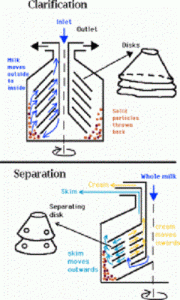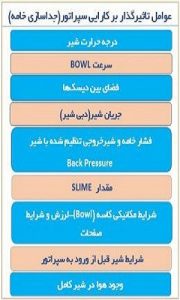What is a separator?
An English word (Separator) means separator. “Separator”, as its name suggests, is a type of separator system that is used in the filtration system. Its job is to separate air, oil, water and fine and coarse particles from each other.
Separator Machine
We must say that the separation process consists of dividing the raw materials into two separate streams, where the two separated parts are determined according to the surface and size of the particles. The separating device separates the particles according to their surface or size. The basis of the work of the separator device is on the density of the material, and on this basis, they separate the soft products from the rough ones.
A separator is a mechanical machine that separates different non-metallic materials in a liquid-solid, liquid-liquid or liquid-gas mixture. For example, when water is mixed with fuel or oil is mixed with air, these materials are separated from each other with the help of a separator
Application of separator in dairy industry:
A separator in the dairy industry is a device for separating fresh milk, skimmed milk and cream. Skimmed milk is made from fresh milk by completely separating the fat. The rest of the mixture, which is all the milk fat, is called cream. Therefore, cream is a type of oil-in-water emulsion, which is separated from the milk by the separator and due to the application of centrifugal force.
The best temperature for creaming is around 55 degrees Celsius. As the temperature increases, the creaming efficiency increases. Because in this case, the viscosity of the milk decreases and the density difference between the cream and the skimmed milk increases.
After the milk passes through the separator, a certain amount of cream is added to the fat-free milk according to the amount of standardized fat needed to produce milk with different fat percentages.

Separator outputs are:
1 cream
2 skimmed milk
3 seperator flowers
Factors affecting the separation of cream:
1 temperature
2 Separator speed
Compositions of separator mud:
Water 76%, nitrogenous substances (casein) 18%, fat and other substances 3.5%
Factors affecting the efficiency of the separator (cream separation):

-
Cold separation of cream
- Cold separation of cream is done at a temperature of 4-5 degrees Celsius and it provides the possibility of creaming when the milk enters the factory. Also, creaming at cold temperature reduces energy consumption and some costs.
In this case, the amount of fat loss in the rear milk is higher than when the separator operation is performed at a higher temperature.
In some processes, such as making cheese, the thermal process of milk before the process is undesirable, and for this reason, cream separation at low temperature is desirable. Creaming at low temperature produces cream with a higher phospholipid content and the final cream It has better whipping features.
The most fundamental change that takes place in the structure of the separator device during cold creaming is the widening of the space between the plates, in order to move the cold cream with higher viscosity more easily.
